What Animals Live In The Santa Cruz Mountains
Georgia Stigall fell in love with the Santa Cruz Mountains early in life. The rich, orange-red glow of madrone and towering Douglas fir forests, the sun-baked chaparral, and especially the oak grasslands in the bioregion where she was raised stayed with her into adulthood, so much so that in 1996 she purchased land and fabricated a permanent habitation to a higher place the fog in those mountains. Her property is right up confronting a big swath of Midpeninsula Regional Open Space Commune land, and far away from roads and people, making it an oasis from the buzzing urban center of Silicon Valley below, not just for her, but for the many animals who alive in that location.
Simply Stigall doesn't mind sharing. In fact, she specifically chose her site because of the habitat values and all the critters that were on it. "'Location location location' is correct," she says. From a childhood spent camping with her family unit effectually the country, to her past and nowadays work every bit an amateur naturalist and habitat restoration volunteer, her dear of the outdoors is deeply rooted. She does her best to run her property like a nature reserve by leaving the land wild and keeping homo presence to a minimum, effectively extending the protected country next to it. But how many animals live on the land? What are they upward to? Her furred and feathered neighbors don't exactly come over to borrow sugar. Many of them – similar the badgers, gray foxes, and mountain lions — are fantabulous at staying out of sight and gliding through the forest on silent paws. To observe out who was hiding in the shadows, she had to get a chip stealthy.
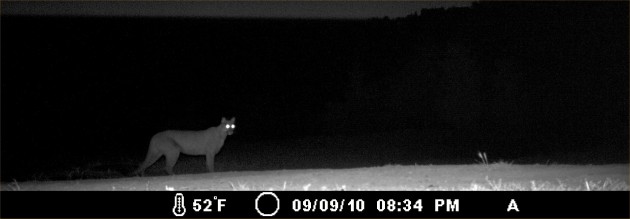
Stigall has installed 12 compact infrared motion-sensor cameras on her property. With military-grade names similar HC500 HYPERFIRE and MOULTRIE M80, the small camouflaged cameras dot the landscape, snapping images both day and nighttime equally critters walk in front of them and trigger the wink. Mount lions peer into the distance, eyes aglow in the reflection of the camera'due south lights, and gray foxes tromp through the grass — moments humans rarely encounter, for a brief moment illuminated. But the cameras capture more than the surprised wanderings of mammals in the night — they also record a variety of information correlated to the prototype, such as the temperature, time and date, fifty-fifty the phase of the moon.
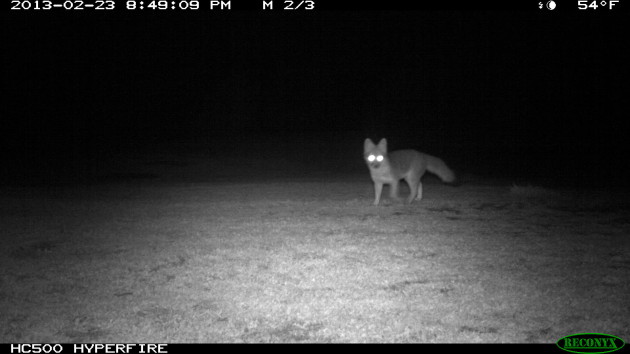
Stigall has been hooked on photographing around her belongings since she began in 2009, and considers the cameras a astounding fashion to become high-quality images of local wild fauna. Although deciding where to install a new camera can sometimes exist a catchy art — and often an exercise in trial and fault — Stigall has a straightforward approach. She will exit each new camera in one place for most a week, and so check the images to see which animals (if any), take been photographed. If there hasn't been a lot of activeness, she volition motility the camera to a new spot. The cameras that have found permanent homes — similar those along the trail, or about the belongings gate, are located in areas where there seems to be a lot of four-footed traffic.
Want fifty-fifty more stories about Bay Surface area nature? Sign upwardly for our weekly newsletter!
Although many of the images are taken at nighttime, the majority of animals on Stigall's property are not strictly nocturnal. She is particularly fond of the transitional periods of the day — the early and late hours as the sun crests or falls below the rim of the mountains when animal activeness is at its highest. "Dawn and dusk are the magic times," she says.
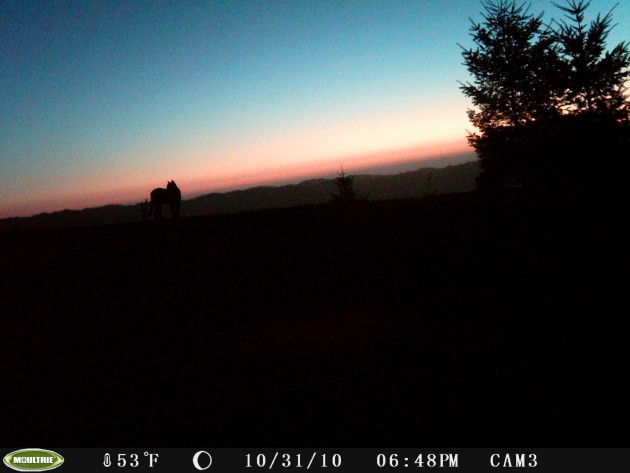
When the sun is upwardly, Stigall normally is as well — out and near on her holding removing non-native plants. She fights a constant boxing with 1 plant in detail — yellow star-thistle — an invasive spiny yellow-flowered institute from the Mediterranean. Introduced to California after the Gold Blitz, yellow star-thistle now infests agronomical fields, vacant lots, parks, and natural areas all over the state. The thistles forbid native species of plants from growing and atomic number 82 to biodiversity loss in areas of dumbo colonization like the grasslands on Stigall's property.
With 16 acres of the grasslands on her property infested with yellowish star-thistle, information technology takes a constant effort to stalk the tide of the spiny hordes. On rare occasions, she says, she gets discouraged, but seeing all the animals thriving on her property keeps her motivated and inspired that the work she is doing is worthwhile. And then she keeps at it, and takes a lighthearted arroyo. "In belatedly July and early Baronial, when information technology's actually hot above the fog, and all I want to do is swim, I say information technology's OK to put down the tools for a little while," she says.

Every bit the above photo shows, Stigall's efforts don't always go unnoticed. A motion-sensor camera captures the scene as two mountain lions crest a ridge on Stigall's property. As i king of beasts saunters towards the camera the other stops and looks off to the right. What caught its attention?
"People ask me that a lot when they see this photo," Stigall says. "Well, it was me!"
She was working noisily merely uphill from where the cats were at the fourth dimension, so although the mount lion couldn't run across her, she assumes that it was her weeding activities that caught the large cat's attention. But that knowledge doesn't worry her. In fact, she loves this picture.
"What I really like about that is he didn't come up to investigate, he walked away from the source," she said.
Mountain lions weigh from 80 to 180 pounds, stand two to three feet loftier, and can reach a length of eight feet from nose to the tail, but generally remain unseen among the littoral forests, arid hillsides, and scrub and oak woodlands where they roam. Nonetheless, Stigall is enlightened of the potential dangers of encountering a mount lion. So she carries pepper spray with her. In Stigall'southward businesslike view, it's worth taking some simple precautions in order to be able to share the land with wild animals.
"The best style to keep them prophylactic is to go along ourselves safety," she says. "We accept a moral responsibility to be the ones who think it through, because nosotros tin. Mountain lions aren't harmless only they are blameless."

Stigall isn't quite certain how many mount lions reside on her holding, but there are two adults for sure, as well every bit mountain lion kittens that appear on camera during the Feb breeding season. Juvenile mountain lions stay with their mothers for up to two years and and so disperse to institute their own territories, which range widely, but can vary from fifty-400 square miles for a male, and typically less than half of that size for a female. Dispersal is a very unsafe fourth dimension for mountain lions, when the young animals are trying to find a place to become they must often travel across busy highways, like Highway 17, or brim the edges or fifty-fifty enter suburban neighborhoods where they are oft shot over public condom concerns.
Stigall says she takes great satisfaction in keeping her land a safe oasis. And she believes that wildlife photography tin instill a greater appreciation for the nature in our own backyards. She often encourages others to purchase a camera or 2 (or 12) and put them effectually their holding.
"One doesn't demand a large parcel to do good from having them," she says. "I do 'warn' people … once yous have one camera, you'll want more than than one! But if y'all have a large packet, even 1.5 acres, you are going to want more one camera. It's so entrancing."
She says she often hears from people who accept bought a photographic camera but don't know quite where to put it. Her advice is simple: "Just put it out there and run into who you get. They're easy to move."
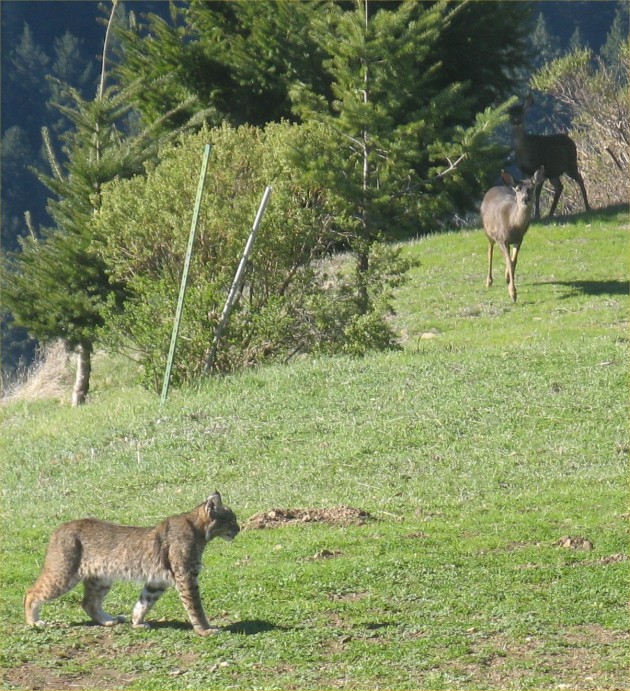
Stigall as well takes many photos with a handheld photographic camera, peculiarly of bobcats, coyotes, deer, and birds. The above image of a bobcat stalking gophers in the field in front of her business firm was taken from a window 15 feet away. With their blackness-tufted ears, short "bobbed" tail, and whiskery confront, bobcats are distinctive. Although more often than not most active at twilight and dawn, they are known to stay up for a few hours later sunrise; during the colder months of autumn and winter they respond to the increased activity of their prey during the day by staying upwards later themselves.
A lifetime spent observing and reveling in this bioregion has clued Stigall into certain times when she is more than probable to run across bobcats than others, like after a pelting, when sunshine is beating down on the wet soil, and gophers become actually active. "You can almost predict when the bobcats will prove upward," she says. She fifty-fifty coined a term, "bobcat conditions," to draw the phenomenon.
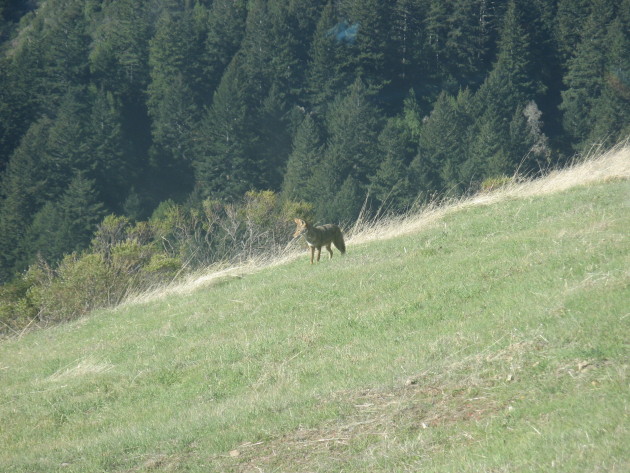
Coyotes are also primarily nocturnal, but tin exist seen during the twenty-four hours, especially in areas with depression man pressure. Stigall more often than not photographs them with a handheld camera as they wander the grasslands on her property.
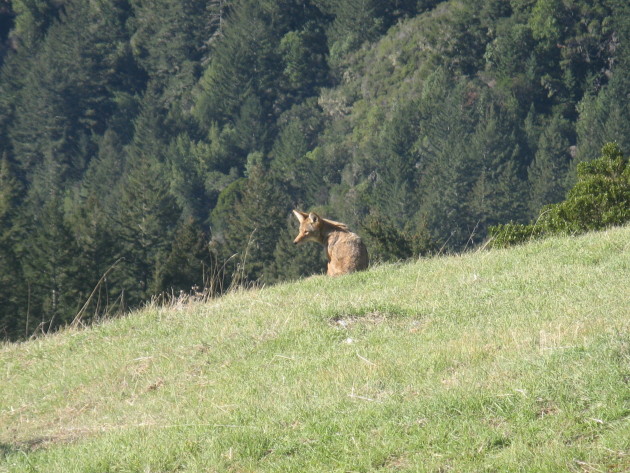
Stigall oftentimes shares her mountain panthera leo images with the researchers at the Santa Cruz Puma projection, who collar and track pumas in the Santa Cruz Mountains in order to get a better understanding of their physiology, beliefs, and the potential impacts of human development that is fragmenting their habitat. But sometimes only taking in the wonder of nature is the all-time reward. "The day we saw a mountain king of beasts in front end of the business firm I had no desire to grab a camera," she says. "I was enthralled."
In that location are also more than 70 bird species on her belongings. She sees peregrine falcons unremarkably, corking-horned owls, western screech owls, pileated woodpeckers, and bald eagles. But she cautions confronting just looking up. During her time leading crews for the National Park Service, she instructed people to wander through the meadows looking for insects similar ladybugs and sphinx moths. Her appreciation for the natural world ranges from large to pocket-sized, hirsuite to feathered to scaled, and she says she hopes to inspire others to feel the same. "Await around," she says. "You never know who yous volition encounter."
Source: https://baynature.org/article/home-mountain/
Posted by: marshpabeggetur.blogspot.com

0 Response to "What Animals Live In The Santa Cruz Mountains"
Post a Comment